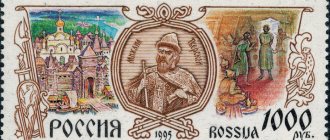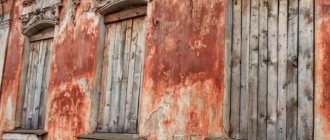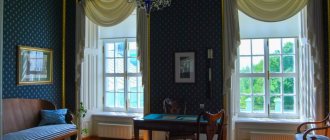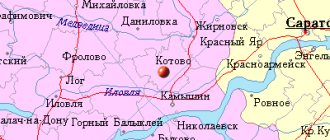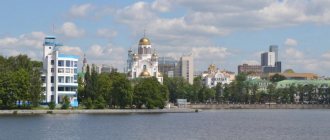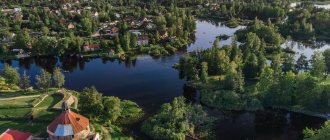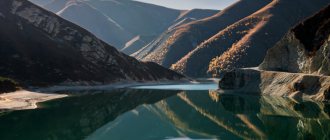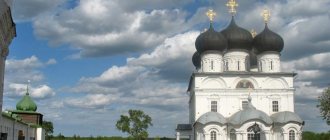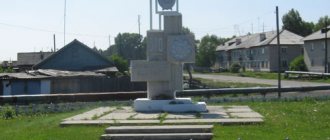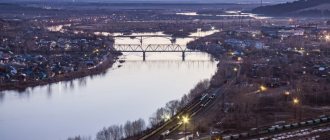Tver city is not the largest regional city in the Central Federal District. Its population is a little more than 400 thousand, the area of the city, located on the two banks of the upper Volga, is only 152 square meters. kilometer
Historians have still not come to a consensus about the age of the settlement. Nevertheless, it seems to us that we can distinguish the stages of “growing up”:
Fortress in Tver
The first chronicle mention of the toponymic name dates back to 1135. The settlement was already crowded and developing rapidly. In “Russian History” (18th century), the historian Tatishchev assumed that the settlement was founded in 1181 - the construction of a fortress (firm) in the lower reaches of the Volga is mentioned. Apparently, this is where the name of the area came from - Tver. As a city, it began to develop after the invasion and destruction of the fortress by the Golden Horde.
As part of the Russian Empire
Very soon Tver became the center of the liberation movement from the Golden Horde, gaining political strength. For two centuries, the principality fought against Muscovy for its independence, demonstrating the strength and inaccessibility of the fortress. Only at the end of the 15th century were Moscow troops able to capture Tver, which forever lost its independence and became part of the Russian state.
From now on, it played a significant role in the development of trade routes. The city became the first seaport built on the great Russian river, and then became a province of the St. Petersburg province
Renaming
The city bore its name for several centuries, until during the Soviet years it was renamed Kalinin (in honor of the All-Russian headman, born in Tver). At this time, the industrial production of the territory was developing, at the same time, ancient monuments were being destroyed and churches were being destroyed. After almost 60 years, the city was returned to its historical name.
Ethnic composition
The All-Russian population census, which was carried out in 2010, showed that the majority of residents of Tver consider themselves Russian. About 5 thousand people are Ukrainians. Other ethnic groups are also represented. Among them are Armenians, Azerbaijanis, Belarusians, Tatars, Karelians, Uzbeks, Tajiks. The share of Chuvash, Jews, Germans, Mordovians, Georgians, Bashkirs, Kazakhs and others is insignificant. There are Azerbaijani and Armenian dynasties in Tver.
Climate and disasters of Tver
The regional Upper Volga lowland, which influences its climate, is temperate continental. Such “moderation” would be comfortable for living if not for the high humidity, bordering on 90 percent. This is due to the fact that the city is located on both banks of the Volga, with the Tvertsa, Tmaka, Lazur, and Sominka rivers flowing through it.
.
Natural disasters also happen in Tver. Residents of the Moscow and Leningrad regions in the winter of 2012-2013 cursed the Tver roads, which city services could not clear of snow debris for several days. Hundreds of vehicles were captured for several days. In the spring, the Volga received an unprecedented amount of water, and an extraordinary flood began: all the piers went under water, and the River Station almost flooded.
In the summer, a hurricane of unprecedented force occurred in Tver, which demolished the roofs of houses, felled trees, and cut wires.
Unprecedented frosts occur in the city - on New Year's Day 1979, the air temperature dropped to 44 degrees below zero. In August 2010 there was almost the same temperature with a plus sign.
Automobile highways
Federal highways pass through the city of Tver:
- M10 "Russia" is a main road that has the status of an object of federal significance. It is part of the European routes E105 and E18, as well as part of the Asian route AH8. The total length of the road is 697 km. The route originates in Moscow and passes through Veliky Novgorod and Tver. The final point of the route is the city of St. Petersburg. The road surface of the highway is asphalt.
- E105 is a European route with a total length of 3,770 km. The route passes through the territory of the following countries: Russia, Ukraine, Norway. The highway originates in the city of Kirkenes and runs through Murmansk, Moscow, Belgorod, Kharkov, Tula, Orel, Simferopol. The final point of the route is Yalta.
Ecology in Tver
Tver is a large industrial center, where there are enterprises in the fuel and energy complex, mechanical engineering, and the chemical industry. Moscow is located 138 kilometers from the regional center - often winds from the metropolis carry smog to small Tver.
Local ecologists have identified several pockets of instability:
- Right bank part – negative impact of thermal power complex enterprises, chemical industry and municipal wastewater treatment plants was noted
- Historical center – a huge amount of traffic is concentrated on narrow streets
- Proletarsky district - negative impact of the Tverskaya Manufactory, the western part of the region where the railway passes
- Zavolzhsky district - unfavorable environmental situation in the area of operation of the largest enterprise of Tver Carriage Works
- North-eastern part of the right bank - the maximum permissible concentration of harmful substances at the construction materials plant has been exceeded.
Economy
Tver produces 40% of the region's industrial output. The main industries are mechanical engineering, chemical and light industry.
There are two large printing plants in the city, and there are mechanical engineering, construction materials and food industry enterprises.
The largest enterprises of the city: OJSC Tver Carriage Building, OJSC, Holding Group "Melkombinat", OJSC "Sibur-PTF", OJSC "Volzhsky Baker", CJSC "Khleb", CJSC "Dielectric Cable Systems", OJSC "Tsentrosvar".
//
Back to contents
Population
According to 2014 data from Rosstat, the city is home to just over 410 thousand people. They are divided according to nationality as follows:
- Russians (more than 90 percent)
- Ukrainians (one and a half percent)
- Belarusians (one percent)
- Karelians (half a percent)
Germans, Chechens, Armenians, Gypsies, Chuvashs, and Azerbaijanis also live in the city.
Since 1989, when the population of Tver reached 450 thousand people, there has been a steady process of decline in the number of city residents. And it’s not so much a matter of natural decline: young active people are leaving for the capitals in search of work. Hence, the city’s demographic problems: aging population, declining birth rate.
According to Rosstat, the region ranks 34th in Russia in terms of population. The share of Tver residents in the Russian Federation is slightly less than one percent.
The unemployment rate in Tver is half that of the region as a whole. According to the information of the Main Directorate for Labor and Employment of the Tver Region, it is 0.4 percent as of October 1, 2014, and 0.9 percent for the region as a whole. But Rosstat gives other data - the Tver region is in last place in the Central Federal District in terms of unemployment - 5.4 percent.
The number of unemployed is 38,400 people (data as of October 1, 2014). Something doesn’t fit in with the information from the statistical authorities, which knows everything, and the government of the Tver region.
Small and medium-sized businesses employ over 70 thousand people.
Housing and communal services tariffs
Utilities in Tver increased in 2022 and increased again in 2022. On the website of the Government of the Tver Region you can see the current prices for electricity, water, gas and other types of utilities.
On websites, Tver residents constantly complain about the work of housing and communal services employees. After all, residents of houses often have to deal with non-functioning sewage systems and untimely garbage collection.
Many people complain about high tariffs and the services provided. City residents believe that prices do not correspond to the quality of communal services.
In 2022, the cost of housing and communal services was:
- electricity – 4.27 rubles/kW;
- water supply - 21.95 rubles;
- water disposal - 22.72 rubles;
- gas – 8,342 rubles/1 m3 (for water heaters and cooking);
- gas – 5,475 rub./1 m3 (heating);
- waste disposal – 96.5 rub. from one person who is registered in a house or apartment.
Not all companies that serve apartment buildings and the private sector have increased heating and gas tariffs. They achieved this through city subsidies allocated for utilities.
Tver is proud of them
The galaxy of famous people of the Tver land dates back to the time when the city played a major role in the formation of the Russian state.
At the turn of the 13th and 14th centuries, Mikhail Yaroslavich Tverskoy fought with the Moscow house of Rurikovich for the independence of his principality.
Tver is associated with the name of Karl Ivanovich Rossi, who at the beginning of the 19th century supervised architectural work in the city and rebuilt the Imperial Palace.
Grand Duke Vasily the Dark was hiding in Tver after the defeat from the troops of Yuri Dolgorukov. Afanasy Nikitin, Tver merchant and traveler, the exact year of his birth is not known. At the end of the 15th century he traveled to India.
Alexey Fedorovich Golovinsky, hereditary honorary citizen. He served as mayor for 30 years.
Born here:
- Mikhail Kalinin, All-Russian headman
- Andrey Tupolev, TU aircraft designer
- Andrey Dementyev, poet
- Mikhail Krug, poet and composer
Story
Start
In non-chronicle written sources, Tver was first mentioned in 1127−1135. Birch bark letters found on the territory of the Tver Kremlin date back to the end of the 12th - beginning of the 13th centuries.
According to ancient written sources, in the second half of the 12th century, Tver was a small fortress on the western border of the Suzdal principality. In the first third of the 13th century it was part of the Pereyaslav Principality. In 1238, the city was devastated by the Mongol-Tatars, but quickly recovered from the defeat.
In the 1240s. The Great Tver Principality was formed, which became one of the political and cultural centers of Rus'. The Tver region is becoming the most important trade and craft region; the route from Novgorod to Moscow passes here.
The city grew quickly. In 1265 Tver became the center of the diocese. Even the devastating fires of 1276 and 1282, typical of wooden ancient Russian cities, could not prevent the growth of the city. At the turn of the 12th – 14th centuries, during the reign of Grand Duke Mikhail Yaroslavich, Tver was the center of the Russian state.
//
Grand Duke Mikhail Yaroslavovich of Tverskoy
Mikhail Yaroslavich Tverskoy (1271-1318) - Grand Duke of All Rus', Prince of Tverskoy (1282 or 1286-1318), in 1305-1318 - Grand Duke of Vladimir. He waged a continuous struggle with Novgorod and with the Moscow prince Yuri Danilovich. By order of Khan Uzbek, he was killed in the Golden Horde, after which the great reign passed to Moscow Prince Yuri Danilovich.
The date of Mikhail Tverskoy’s ascension to the Grand Duke’s throne is interpreted in various sources as either 1304 or 1305. This is due to the fact that the Grand Duke of Vladimir Andrei Alexandrovich, who died in 1304, bequeathed the great reign to Mikhail, but the Moscow Prince Yuri Danilovich also laid claim to the grand-ducal throne. Mikhail and Yuri went to the khan for trial. As a result, Mikhail received the khan’s charter in 1305 and, having arrived in Vladimir, was promoted by Metropolitan to the throne of the Great Reign.
In the correspondence between Michael and the Patriarch of Constantinople Niphon I (held in 1310-1314), the address Grand Duke of All Rus' was used - to date, this is the first known use of such an address to the rulers of Rus'.
Death of the Grand Duke
In 1317, another armed conflict occurred between Mikhail Yaroslavich of Tver and Yuri Danilovich of Moscow, known as the Battle of Bortenev, as a result of which Yuri’s wife, Konchak (sister of Uzbek Khan, great-granddaughter of Genghis Khan), was captured by the Tver prince. Soon she died in Tver (according to some sources, she was poisoned by Muscovites in order to turn Uzbek against the Tver prince), and the struggle flared up with renewed vigor. Both princes were forced to go to the Horde. The Khan's trial took place, after which Mikhail Tverskoy was put in stocks. A month later, after much torment and bullying, the Grand Duke was killed by the people of Yuri Danilovich and Kavgady, a Tatar supporter of the Moscow prince. The coffin with the body of Mikhail Yaroslavich was transported to Tver only a year later, after the conclusion of an agreement between Yuri and Mikhail Tverskoy’s son Alexander. Prince Mikhail Tverskoy was buried in the Transfiguration Cathedral of the city on the banks of the Volga. Mikhail Tverskoy was canonized by the Russian Orthodox Church in the ranks of the faithful in 1549. On May 23, 2008, on the central square of Tver - Sovetskaya - a monument to the city's heavenly patron, Holy Blessed Prince Mikhail Yaroslavich, by sculptor Andrei Kovalchuk was unveiled. In the City Garden of Tver, near the Volga Descent, a worship cross was built, and at the place where the Tmaka flows into the Volga, the Church of Mikhail Tverskoy was erected.
Tver in the Moscow Principality
After the death of Mikhail Yaroslavich, the grand-ducal throne passed to Moscow. Tver and the surrounding lands were annexed to the Moscow Principality in 1485 under Ivan III. During the reign of Ivan IV the Terrible, by his order, Tver was devastated: the city was burned, more than 10,000 residents died. After this terrible shock, the city was no longer able to achieve its former greatness and never again laid claim to the role of the capital.
Restoration of Tver
In 1763, a severe fire destroyed the central part of Tver, and ten years later the Trans-Volga side burned out. By order of Catherine II, an entire “architect team” was created under the leadership of P.R. Nikitin, whose goal was to rebuild the center of Tver in stone according to a regular layout. The main features of this layout were the long axial Millionnaya Street (now Sovetskaya), so named because a million rubles from the tsar’s treasury were allocated for the construction of stone houses in the city center; as well as the “Versailles trident”: a three-ray composition of streets converging at one point, modeled after a similar urban planning technique in St. Petersburg.
In 1764-1766, the main architectural landmark of Tver was erected - the Traveling Palace of Empress Catherine. The palace was built in the classical style with baroque elements according to the design of M. F. Kazakov, at the same time, between the Travel Palace and the Volga, the City Garden was laid out, which is a favorite place for the townspeople to hang out today.
In the 19th century, the center of Tver was decorated with several more notable buildings - the house of noble meetings (now the House of Officers, architect I. F. Lvov), the ensemble of administrative buildings on Octagonal (Lenin) Square, etc. In 1851, movement began along the Nikolaevskaya railway, connecting Tver with St. Petersburg and Moscow. In 1900, a permanent bridge across the Volga was built in the city according to the design of the Czech engineer L. Mashek.
The twentieth century
In 1931, Tver was renamed Kalinin in honor of a native of the Tver province M.I. Kalinin. In the 30s of the 20th century, during the fight against religion, dozens of churches and architectural monuments of the 17th-19th centuries were demolished. In particular, in 1935 the Transfiguration Cathedral was blown up.
The Great Patriotic War caused great damage to the cities of the Tver region, when many architectural monuments were destroyed, factories and enterprises were destroyed. The post-war restoration of the region was primarily aimed at economically significant objects.
After the Great Patriotic War, a second bridge appeared in the city. The disassembled elements of the bridge of Lieutenant Schmidt from Leningrad were used as the spans of this bridge.
In 1980-1990 work begins on the restoration and study of temple architectural monuments, many of which were destroyed under Soviet rule.
In 1990, the city returned its historical name and coat of arms.
Back to contents
Economy of the region and regional center
According to the Ministry of Economic Development, economic activity in the region decreased in the first half of 2014. The production of goods and the volume of services provided in monetary terms amounted to 126 billion rubles, or 100.4 percent compared to last year. This is lower than the national figure (101.5 percent) and the Central Federal District (102.4 percent).
Having analyzed the indicators of economic development of the region, we can conclude that the decrease in activity occurred due to manufacturing enterprises, which account for more than 62 percent in the structure of the regional economy.
These industries fell short of the comparable period in 2013 by 0.6 percent. Agricultural production indicators decreased - less than 93 percent compared to the first half of 2013.
Regional budget revenues increased by 11 percent and amounted to 28.7 billion rubles. These funds were not fully utilized: the regional treasury spent only 26 and a half billion rubles.
The average monthly salary in the region increased by 8 percent and is reaching 24 thousand rubles.
The budget of the regional center in 2014 is 6.66 billion rubles, expenses are 6.88 billion rubles. The public debt of the municipality is 2.4 billion rubles.
According to the results of the Rating of Sustainable Development of Cities of the Russian Federation, Tver entered the Top of the best cities whose population does not exceed 500 thousand people (SGM rating agency for 2013, the indicators of 173 cities with a population of over 100 thousand people were studied).
The largest cities in the Tver region by population
There is not a single million-plus population in the Tver region. The most densely populated area is the capital of the region - Tver, where 420,065 people live. In other cities, the number of residents does not even reach 100,000, and in eight of them it is less than 10,000. Since 1989, the number has been steadily falling: over 30 years it has decreased by more than by 400,000.
The most populous cities in the Tver region include:
- Tver - 420 065.
- Rzhev - 59,422.
- Vyshny Volochek - 46,908.
- Torzhok - 45,641.
- Kimry - 44,743.
- Konakovo - 38,486.
- Udomlya - 28,119.
- Bezhetsk - 21,179.
- Bologoe - 21,158.
- Nelidovo - 18,883.
Investments in fixed capital
According to the Ministry of Economic Development, in 2014 the volume of investments in fixed assets of enterprises in the Tver region decreased compared to 2013. In total, in the first half of 2014, 23 and a half billion rubles were allocated to the economy - 70 percent of the comparable level in 2013.
There are many large, already completed investment projects in the region:
- Construction of an enterprise for the production of HITACHI brand excavators. The total investment in the largest project amounted to 3 billion rubles. The company employs 250 people
- Tver is a monopolist in Russia in the production of passenger cars for railway transport. In 2012, the SKF-Tver enterprise was created to produce bearings for railway cars. The volume of investments amounted to 1.2 billion rubles
- Among the agricultural investment projects, the Verkhnevolzhskaya poultry farm is considered the largest - more than two billion rubles of investment.
Culture and art
//
Tver is a major cultural center.
Residents and guests of the city can enjoy the country's famous drama theatre, philharmonic society, children's and youth theatre, puppet theatre, and circus.
The art gallery exhibits works by many outstanding Russian artists of the 18th – 20th centuries and masters of Western European art.
The Tver Province was often visited by the great Russian poet A.S. Pushkin.
The fabulists I.A. Krylov, A.E. Izmailov, the artist O.A. Kiprensky, the writers I.I. Lazhechnikov, M.E. Saltykov-Shchedrin, F.M. Dostoevsky, A. lived, studied and worked in Tver. N. Ostrovsky.
Tver Regional Academic Drama Theater
//
Founded in 1921 as the Tver Theater of the RSFSR No. 1, later - the First State Theater. Received its modern name in 1935.
The repertoire is based on Russian and foreign classics and modern plays. Since 1993, students of the Shchepkinsky Theater School have been training on the basis of the theater.
Performances of different years: “The Cherry Orchard” (1975, 2000) and “The Seagull” by A. P. Chekhov, “Wolves and Sheep”, “The Last Sacrifice” and “Dowry” (1992) by A. N. Ostrovsky, “Precipice” I Goncharova, “Anna Karenina” by L. N. Tolstoy (1994, 1996), “Mother” by K. Capek, “Love under the Elms” by Yu. O’Neill (1984) and many others.
The main directors who worked at the theater were: G. Georgievsky (1941-1965), V. A. Efremova (since 1974).
Tver State Academic Philharmonic
//
The Tver (Kalinin) Philharmonic was founded on October 26, 1936.
Today the Tver Academic Philharmonic is one of the leading philharmonic societies in Russia and the most important concert and educational institution in the Tver region. In terms of the number of large-scale cultural events and festivals of all-Russian and international significance, the Tver Philharmonic is not inferior to other regions of Russia. Thus, every year the Philharmonic organizes and conducts: the festival “Musical Autumn in Tver”, the International Music Festival of I.S. Bach, International Festival of Jazz Music, Christmas Festival of Choral Music in Tver “With Faith in the Third Millennium”, art festival dedicated to A.S. Pushkin “Times pass - poetry and music remain”, music festival dedicated to S.Ya. Lemeshev “I See Wonderful Freedom”, Opera and Easter festivals.
Every year, on its own, the Philharmonic produces up to 45 new programs, including subscription and children's programs, goes with concerts to the region, to other regions of Russia, abroad, holds competitions, gives charity concerts for veterans, for orphans and children from low-income families, organizes ceremonial events.
Theater for Young Spectators
//
The Tver (Kalinin) Youth Theater was founded in 1932. Every season, seven or eight new performances appeared in the theater. At the end of the 30s. Artists of the Kalinin Youth Theater took part in the First All-Union Review of Theaters for Young Spectators, where they successfully showed their productions. Kalinin Youth Theater was recognized as one of the best theaters in the Soviet Union.
During the Great Patriotic War, most children's theaters were disbanded - the artists went to the front. The Kalinin Youth Theater was closed and received spectators again only 20 years later - in 1960.
Over the past 50 years, many talented actors and directors have worked in the theater. The Tver Youth Theater is notable for the fact that its repertoire has always included not only children's performances. An innovative approach to production, bold experiments with music, light and decorations are the hallmark of the Youth Theater. From the time of its opening to the present day, the Tver Theater for Young Spectators has its own recognizable face, individuality, expressed in what was created and is being created on its stage. He has a special atmosphere of creative freedom. The repertoire is based on performances for children and teenagers: “The Little Mermaid”, “Brother Rabbit and Others”, “According to Emelin’s Wish”, “Peter Pan”, “Elena the Wise”. But there are also productions for adults based on the works of classics and modern Russian and foreign authors (M. Bulgakov, J. Giraudoux, N. Gogol, F. Dostoevsky, G. Gorin, etc.).
Tver State Puppet Theater
//
The Tver (Kalinin) State Puppet Theater was created in April 1944 during the difficult times of the Great Patriotic War. Since 1958, the Kalinin Puppet Theater has become a member of UNIMA, the international union of puppet theater workers.
The theater team has toured several times and participated in festivals in Moscow, St. Petersburg, Ryazan, Kiev, Minsk, Vologda, other cities in our country and abroad: in Hungary, Bulgaria, Germany, Spain.
Performances of recent years: “Morozko” by M. Shurinova, “Wild” by V. Sinakevich, “Cinderella” by S. Belkin, “Aibolit and Barmaley” by V. Korostylev, “Kid and Carlson” by A. Afanasyev, “Geese-Swans” by E. Anokhina, “Puss in Boots” by Y. Rokhlin, “Dwarf Nose” by S. Belkin, “Thumbelina” by B. Zakhoder, “Aladdin’s Magic Lamp” by A. Afanasyev based on oriental fairy tales, “Fun Concert” by S. Belkin, “Sadko” S. Belkin based on the Russian epic. The theater also staged performances for adults “Variety” and “Until the Third Rooster”.
All these performances are a search for new means of expression, a way not only to speak the language of theatricality, but also to pose complex moral tasks to the viewer.
Back to contents
Administrative districts of Tver
The city is located on the banks of five rivers, which determines its administrative division into four districts:
Central
Includes the entire historical part of the city. This area is on the right bank of the Volga. The small Tmaka River divides the territory of this area into parts. There are practically no large enterprises in this area - only 2 bakeries and clothing production. The private sector is concentrated here more than in other areas.
Zavolzhsky
The district includes the entire left bank part of Tver. Here the Tvertsa River flows into the Volga River. At the same time, on the territory of the Zavolzhsky district there is the pride of modern Tver - a carriage building plant, where about 8 thousand people work. Geographically, the district includes the embankment of the merchant Afanasy Nikitin (“Walking across Three Seas”), which has become a favorite place for walks for city residents. Wedding processions come here. Construction of new houses is underway in the Yunost and Sominka microdistricts.
Moscow
It includes the entire eastern part of the city, located towards Moscow. Large enterprises are located here: an excavator plant, a meat processing plant, a flour mill, a printing plant, a brewery and a logistics center. Here are the Chaika and Yuzhny microdistricts, the villages of Bolshie and Malye Peremerki, where there are free development zones. The area is very green, on its territory there is a natural monument - Bobachevskaya Grove.
Proletarian
It includes the western part of the city. Previously, the area was a working-class suburb of the regional center. Sewing enterprises are concentrated in the Proletarsky district: the Proletarka factory, built by the merchant Savva Morozov (Tverskaya Manufactory Partnership), the Rozhdestvenskaya Manufactory, and a worsted factory. There are timber processing enterprises and a printing plant that produces children's literature. A shopping and entertainment center was recently built on Kalinin Avenue.
Train Station
Tverskoy railway station is a division of the North-Western Regional Directorate of Railway Stations. Located at st. Comintern, 18. The opening date of the railway station is 1850. The number of platforms is 4, the number of tracks is 5. The shape of the platforms at the station is straight. Free car parking is available on the station premises. In the main building of the Tverskoy railway station, passengers have access to a spacious waiting room, storage room for luggage and personal belongings, a medical center, and ticket offices.
Every day more than 140 long-distance trains pass through the station in the following directions: Moscow, St. Petersburg, Ufa, Murmansk, Helsinki, Yeisk, Novorossiysk, Anapa. Also on the Oktyabrskaya Railway there is a high-speed electric train called Sapsan, which follows the Moscow-St. Petersburg route.
New buildings in Tver
The construction boom in Tver dates back to 2011, when 210 thousand square meters of housing were commissioned, which is 2.2 times higher than in 2000. The main development is carried out by large companies, Tvergrazhdanstroy and Tver Investment Construction Company.
- In the Central District, the old housing stock is being renewed. Given the existing dense buildings, no new construction is taking place in the historical center.
The cost of attic apartments starts from 46 thousand rubles per square meter, according to real estate agencies. Two thousand rubles more expensive per square meter in luxury new buildings in the Central District. In the elite houses of the historical center, the cost per square meter is 70 thousand rubles. On Semeonovskaya and Chernyshevsky streets the highest housing prices are 95 thousand rubles per square meter.
- In the Zavolzhsky region, several zones can be distinguished for comfortable living.
The Near Trans-Volga region, which starts from Blagoeva Street and leads to the River Station, is an area of pedestrian accessibility. The price per square meter of housing is 56 thousand rubles. In high-rise buildings with individual layouts on 2nd Krasin Street, the developer sells apartments for 50 thousand rubles per meter.
- A new residential complex “Forest Melody” (Ordzhonikidze Street) is being built in the Moskovsky district.
Two 17-story residential buildings with a built-in kindergarten are being built here, there are sports and children's playgrounds, and shops. The cost of housing in a complex with a poetic name starts from 37 thousand rubles.
In new buildings in the Yuzhny microdistrict, housing is more expensive - the average price is 46 thousand rubles. The Phoenix residential complex is planned to be put into operation in the first quarter of 2015, after the landscaping of the mass development has been carried out.
- In the Proletarsky district, new construction is underway in the Mamulino microdistrict.
The developer offers 2-3-room apartments with individual heating at prices ranging from 2 million 300 thousand to three million 400 thousand rubles.
Coat of arms
The coat of arms of Tver is presented in the form of a French shield. A golden chair (without a back) is depicted on a red field. The seat of the furniture is covered with a green cushion with gold tassels and cord around the edges. On it is a golden crown, decorated with gems with five visible leaf-shaped teeth - three large ones interspersed with two smaller ones.
The artistic composition is included in the State Heraldic Register of the Russian Federation under No. 700. It goes back to the historical version. Approved by decision of the Tver City Duma No. 66 of May 25, 1999 (as amended on February 22, 2000).
Transport
Tver is a major transport hub, connected to other Russian regions by air, water, road and rail.
Two major highways pass near the city, one of them is the international highway Moscow - Riga.
Tver River Station, where passenger ships operate from. Pleasure ships depart from the pier on the Stepan Razin embankment.
There are two airfields in Tver: in the Zavolzhsky region - “Zmeevo”. On the western outskirts of the city is Migalovo.
The parts of the city are connected by 8 bridges:
- Starovolzhsky and Novovolzhsky
- Tvertsky and Novotvertsky
- Gorbaty and Migalovsky
- Tveretsky and Tverskoy.
Tver has developed tram, trolleybus, and automobile public transport. With the development of commercial road transport, city authorities have reduced a number of tram and trolleybus routes.
Infrastructure Features
There are hundreds of kindergartens and secondary schools in Tver.
Specialized education can be obtained in the following places:
- vocational schools;
- colleges;
- technical schools;
- state universities;
- branches of Russian and international universities.
Education can be obtained in more than 100 specialties. For high-quality training of professionals and workers, the city administration creates conditions for creative, administrative and scientific activities.
If you are planning to study in Europe or other countries, we recommend that you familiarize yourself with the ranking of the quality of education in countries around the world.
Tver State University. Photo Vodomer / commons.wikimedia.org
The city's infrastructure organically includes the transport system and roads, with which there are certain problems in Tver. The road surface is being updated, but this is not enough. After all, there are broken sidewalks, potholes, and lack of asphalt everywhere.
It can be difficult to get to suburban villages, since there are no normal roads or transport. Traffic jams have become a common occurrence on city roads, which is especially noticeable during rush hours.
The transport system is represented by railways, buses, cars, and public transport, which transports citizens and tourists.
The number of cars in Tver is constantly growing, which complicates the situation on highways. The city has long been known as a major transport hub of the Russian Federation, from where it is easy to get to neighboring settlements.
You can get around the city by buses, trolleybuses, trams, which are gradually being replaced by commercial buses and minibuses.
You can buy food and other goods, the prices of which in Tver are lower than in the capital region, in shopping centers and complexes such as Metro, Pyaterochka and Magnit.
Retail trade enterprises are also open, for example, Auchan and Lenta hypermarkets.
In many areas of the city there are supermarkets and shops open almost 24 hours a day. Such retail establishments are opening next to residential complexes, neighborhoods, and cottage communities so that residents can quickly purchase everything they need for their home.
Tver supermarkets compete with markets. The largest of them is the Tver Central Market, where you can buy vegetables and fruits, sausages, spices, tea, coffee, sausages, etc.
Watch the video: review of prices in Tver stores.
Attractions
The historical part of the city is of interest to tourists from all over the world. The first thing that guests of Tver do is take leisurely walks along the two city embankments.
From the Stepan Razin Embankment, pleasure boats depart every hour along the Volga - this is the best way to see Tver in all its glory and create your own impression of the ancient city.
From the river surface it is clearly visible that there are many churches, cathedrals, and monasteries in Tver. There are more than thirty of them.
Catherine's Travel Palace is considered the main attraction of the former Tver Kremlin. The Imperial Palace was built in the 18th century for the relaxation of the imperial family. Later, the Palace served as the governor's residence, where eminent guests stayed. Now he introduces city guests to Russian and contemporary art - there is an art gallery in the Imperial Palace.
About the city of Tomsk
About Tula
